Abstract
Some patients undergoing ambulatory oesophageal pH monitoring to investigate symptoms suggestive of gastro-oesophageal reflux disease (GORD) are found to have oesophageal acid exposure within the physiological range but show a close correlation between their symptoms and individual reflux episodes. It is suggested that these patients might exhibit enhanced oesophageal sensation, akin to the heightened perception of both physiological and provocative stimuli in the gut that has been described in patients with functional gastrointestinal disorders. This study tested the hypothesis by measuring the sensory thresholds for oesophageal balloon distension and discomfort in 20 patients with symptoms of GORD, in whom ambulatory pH monitoring had shown normal acid exposure times, but in whom the symptom index for reflux events was 50% or greater, and compared these with 15 healthy volunteer controls, and with control groups with confirmed excess reflux. The study group showed lower thresholds both for initial perception of oesophageal distension, and for discomfort, compared with healthy controls (median ml (range)); 7.5 (2-19) v 12 (6-30) (p = 0.002) and 10 (5-20) v 16 (8-30) (p < 0.0001), respectively. Sensory thresholds in the study group were also significantly lower than in patients with excess reflux, and than patients with Barrett's oesophagus, who also exhibited significantly higher sensory thresholds than healthy controls. No differences in sensory thresholds for somatic nerve stimulation were found between the study group and health controls. The results show a spectrum of visceral sensitivity in GORD, with enhanced oesophageal sensation in patients with symptomatic but not excess gastro-oesophageal reflux, suggesting that their symptoms result from a heightened perception of normal reflux events.
Full text
PDF
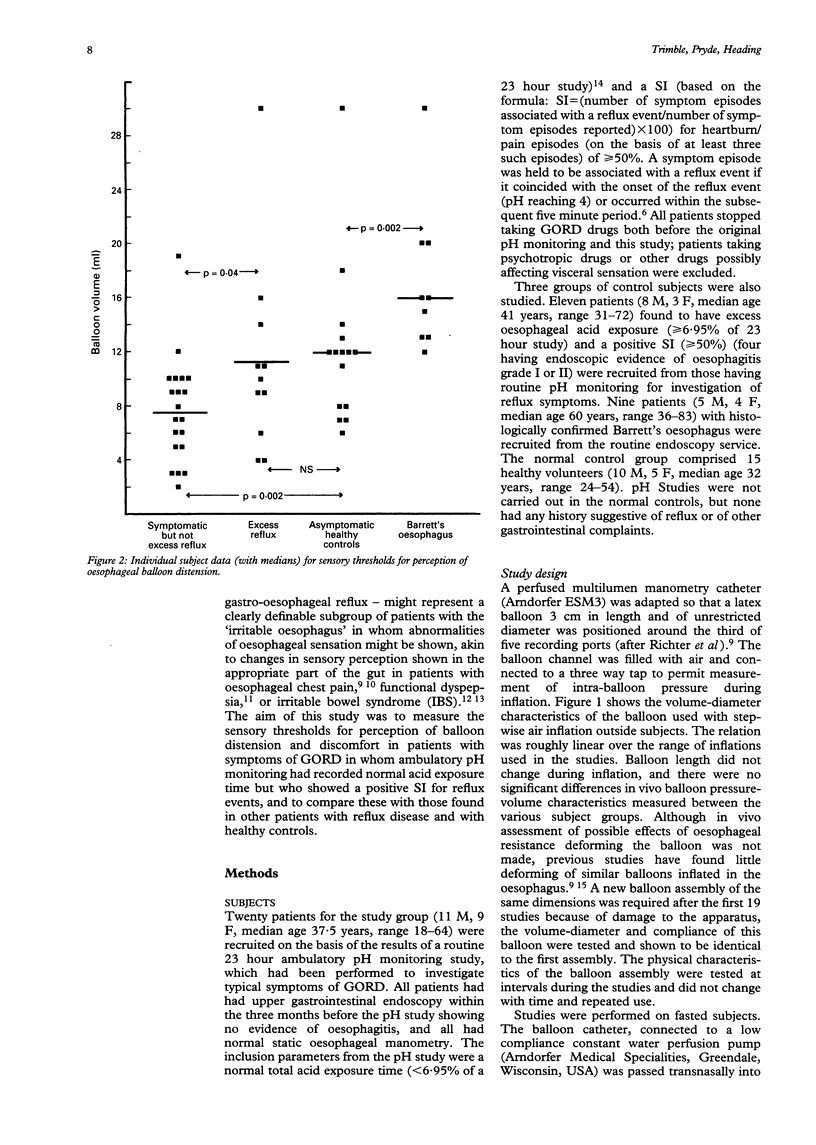
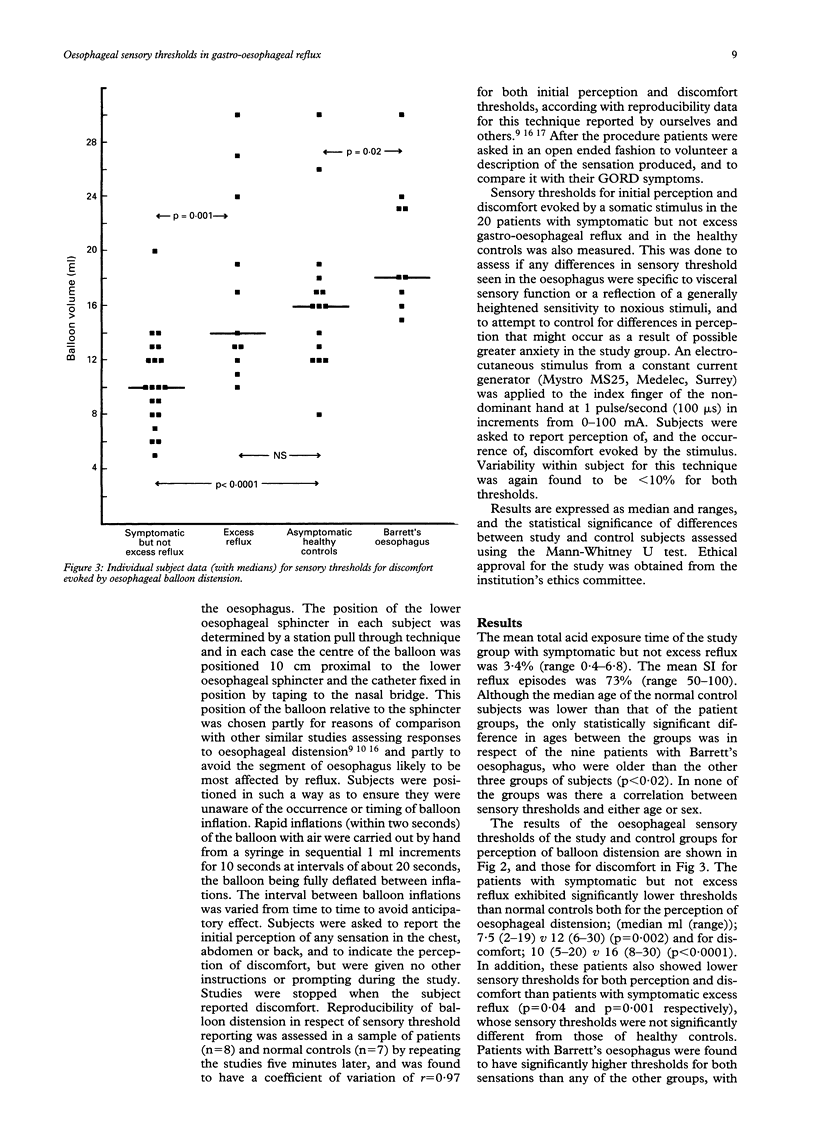
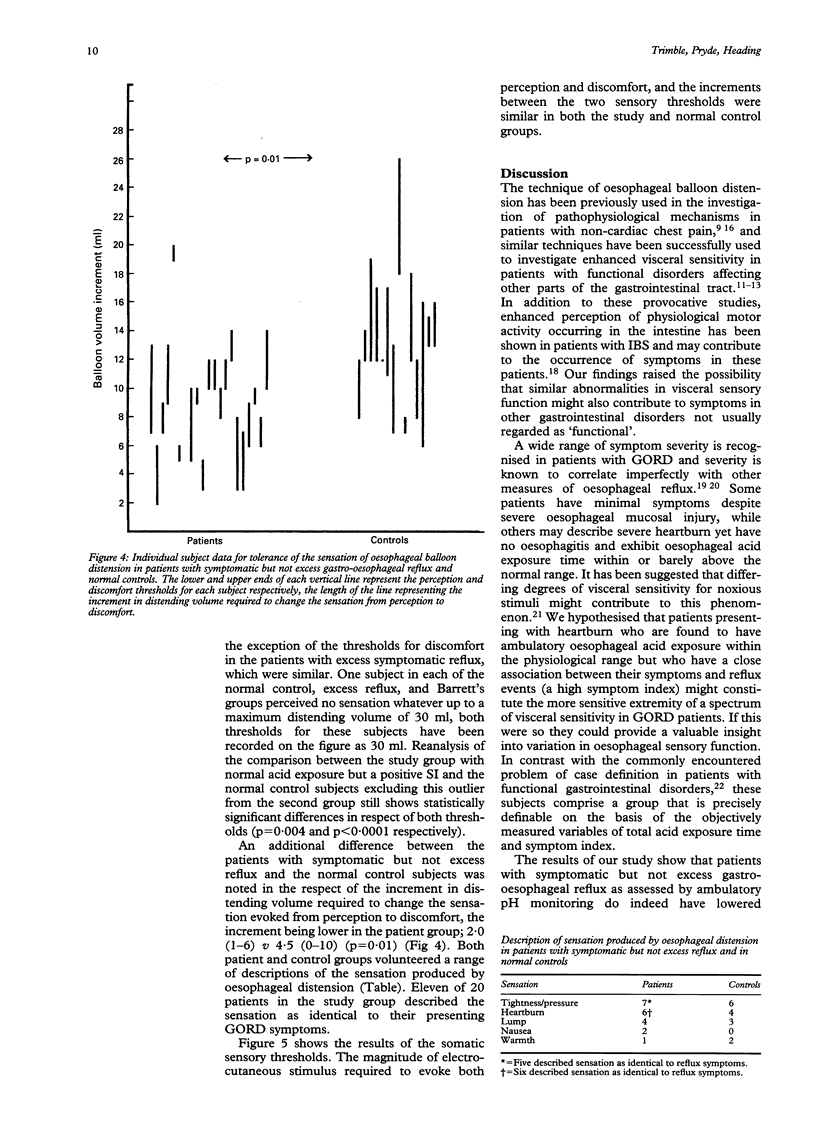
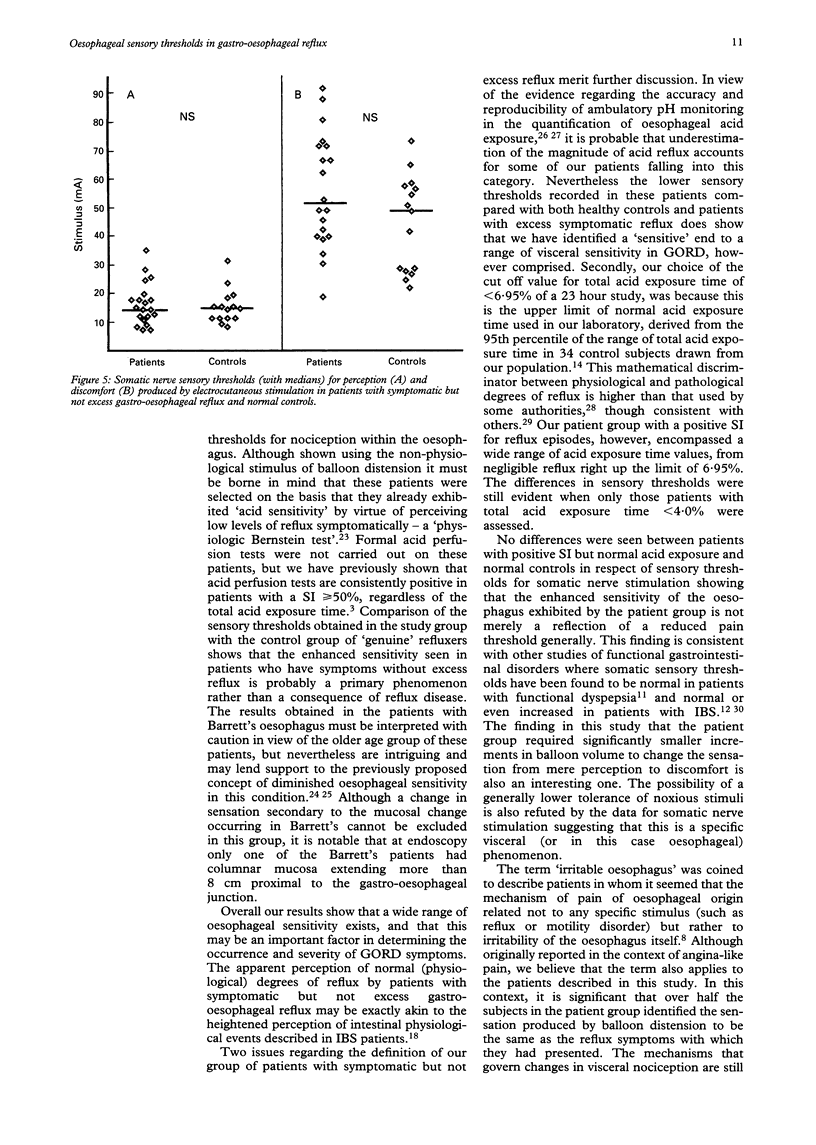
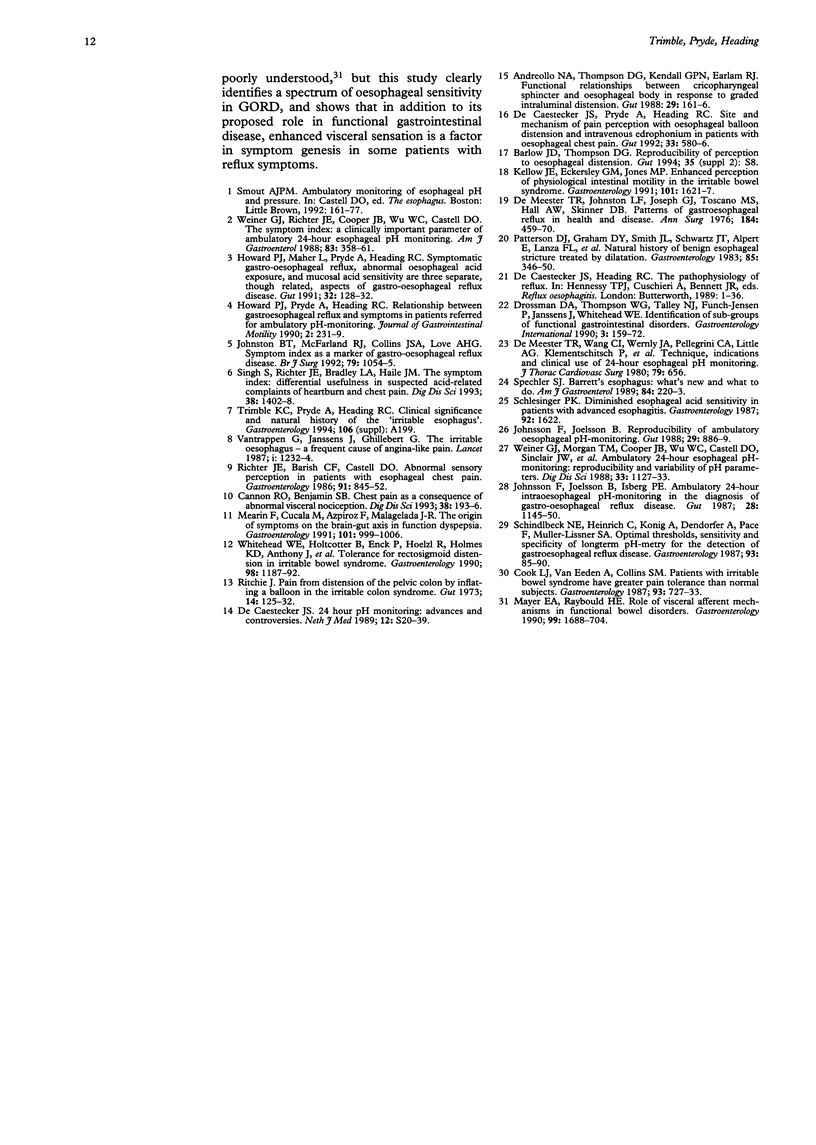
Selected References
These references are in PubMed. This may not be the complete list of references from this article.
- Andreollo N. A., Thompson D. G., Kendall G. P., Earlam R. J. Functional relationships between cricopharyngeal sphincter and oesophageal body in response to graded intraluminal distension. Gut. 1988 Feb;29(2):161–166. doi: 10.1136/gut.29.2.161. [DOI] [PMC free article] [PubMed] [Google Scholar]
- Cannon R. O., 3rd, Benjamin S. B. Chest pain as a consequence of abnormal visceral nociception. Dig Dis Sci. 1993 Feb;38(2):193–196. doi: 10.1007/BF01307534. [DOI] [PubMed] [Google Scholar]
- Cook I. J., van Eeden A., Collins S. M. Patients with irritable bowel syndrome have greater pain tolerance than normal subjects. Gastroenterology. 1987 Oct;93(4):727–733. doi: 10.1016/0016-5085(87)90434-3. [DOI] [PubMed] [Google Scholar]
- DeMeester T. R., Wang C. I., Wernly J. A., Pellegrini C. A., Little A. G., Klementschitsch P., Bermudez G., Johnson L. F., Skinner D. B. Technique, indications, and clinical use of 24 hour esophageal pH monitoring. J Thorac Cardiovasc Surg. 1980 May;79(5):656–670. [PubMed] [Google Scholar]
- Demeester T. R., Johnson L. F., Joseph G. J., Toscano M. S., Hall A. W., Skinner D. B. Patterns of gastroesophageal reflux in health and disease. Ann Surg. 1976 Oct;184(4):459–470. doi: 10.1097/00000658-197610000-00009. [DOI] [PMC free article] [PubMed] [Google Scholar]
- Howard P. J., Maher L., Pryde A., Heading R. C. Symptomatic gastro-oesophageal reflux, abnormal oesophageal acid exposure, and mucosal acid sensitivity are three separate, though related, aspects of gastro-oesophageal reflux disease. Gut. 1991 Feb;32(2):128–132. doi: 10.1136/gut.32.2.128. [DOI] [PMC free article] [PubMed] [Google Scholar]
- Johnsson F., Joelsson B., Isberg P. E. Ambulatory 24 hour intraesophageal pH-monitoring in the diagnosis of gastroesophageal reflux disease. Gut. 1987 Sep;28(9):1145–1150. doi: 10.1136/gut.28.9.1145. [DOI] [PMC free article] [PubMed] [Google Scholar]
- Johnsson F., Joelsson B. Reproducibility of ambulatory oesophageal pH monitoring. Gut. 1988 Jul;29(7):886–889. doi: 10.1136/gut.29.7.886. [DOI] [PMC free article] [PubMed] [Google Scholar]
- Johnston B. T., McFarland R. J., Collins J. S., Love A. H. Symptom index as a marker of gastro-oesophageal reflux disease. Br J Surg. 1992 Oct;79(10):1054–1055. doi: 10.1002/bjs.1800791022. [DOI] [PubMed] [Google Scholar]
- Kellow J. E., Eckersley C. M., Jones M. P. Enhanced perception of physiological intestinal motility in the irritable bowel syndrome. Gastroenterology. 1991 Dec;101(6):1621–1627. doi: 10.1016/0016-5085(91)90400-f. [DOI] [PubMed] [Google Scholar]
- Mayer E. A., Raybould H. E. Role of visceral afferent mechanisms in functional bowel disorders. Gastroenterology. 1990 Dec;99(6):1688–1704. doi: 10.1016/0016-5085(90)90475-g. [DOI] [PubMed] [Google Scholar]
- Mearin F., Cucala M., Azpiroz F., Malagelada J. R. The origin of symptoms on the brain-gut axis in functional dyspepsia. Gastroenterology. 1991 Oct;101(4):999–1006. doi: 10.1016/0016-5085(91)90726-2. [DOI] [PubMed] [Google Scholar]
- Patterson D. J., Graham D. Y., Smith J. L., Schwartz J. T., Alpert E., Lanza F. L., Cain G. D. Natural history of benign esophageal stricture treated by dilatation. Gastroenterology. 1983 Aug;85(2):346–350. [PubMed] [Google Scholar]
- Richter J. E., Barish C. F., Castell D. O. Abnormal sensory perception in patients with esophageal chest pain. Gastroenterology. 1986 Oct;91(4):845–852. doi: 10.1016/0016-5085(86)90685-2. [DOI] [PubMed] [Google Scholar]
- Ritchie J. Pain from distension of the pelvic colon by inflating a balloon in the irritable colon syndrome. Gut. 1973 Feb;14(2):125–132. doi: 10.1136/gut.14.2.125. [DOI] [PMC free article] [PubMed] [Google Scholar]
- Schindlbeck N. E., Heinrich C., König A., Dendorfer A., Pace F., Müller-Lissner S. A. Optimal thresholds, sensitivity, and specificity of long-term pH-metry for the detection of gastroesophageal reflux disease. Gastroenterology. 1987 Jul;93(1):85–90. doi: 10.1016/0016-5085(87)90318-0. [DOI] [PubMed] [Google Scholar]
- Singh S., Richter J. E., Bradley L. A., Haile J. M. The symptom index. Differential usefulness in suspected acid-related complaints of heartburn and chest pain. Dig Dis Sci. 1993 Aug;38(8):1402–1408. doi: 10.1007/BF01308595. [DOI] [PubMed] [Google Scholar]
- Spechler S. J. Barrett's esophagus: what's new and what to do. Am J Gastroenterol. 1989 Mar;84(3):220–223. [PubMed] [Google Scholar]
- Vantrappen G., Janssens J., Ghillebert G. The irritable oesophagus--a frequent cause of angina-like pain. Lancet. 1987 May 30;1(8544):1232–1234. doi: 10.1016/s0140-6736(87)92686-9. [DOI] [PubMed] [Google Scholar]
- Whitehead W. E., Holtkotter B., Enck P., Hoelzl R., Holmes K. D., Anthony J., Shabsin H. S., Schuster M. M. Tolerance for rectosigmoid distention in irritable bowel syndrome. Gastroenterology. 1990 May;98(5 Pt 1):1187–1192. doi: 10.1016/0016-5085(90)90332-u. [DOI] [PubMed] [Google Scholar]
- Wiener G. J., Morgan T. M., Copper J. B., Wu W. C., Castell D. O., Sinclair J. W., Richter J. E. Ambulatory 24-hour esophageal pH monitoring. Reproducibility and variability of pH parameters. Dig Dis Sci. 1988 Sep;33(9):1127–1133. doi: 10.1007/BF01535789. [DOI] [PubMed] [Google Scholar]
- Wiener G. J., Richter J. E., Copper J. B., Wu W. C., Castell D. O. The symptom index: a clinically important parameter of ambulatory 24-hour esophageal pH monitoring. Am J Gastroenterol. 1988 Apr;83(4):358–361. [PubMed] [Google Scholar]
- de Caestecker J. S., Pryde A., Heading R. C. Site and mechanism of pain perception with oesophageal balloon distension and intravenous edrophonium in patients with oesophageal chest pain. Gut. 1992 May;33(5):580–586. doi: 10.1136/gut.33.5.580. [DOI] [PMC free article] [PubMed] [Google Scholar]
- de Caestecker J. S. Twenty-four-hour oesophageal pH monitoring: advances and controversies. Neth J Med. 1989 Mar;34 (Suppl):S20–S39. [PubMed] [Google Scholar]


